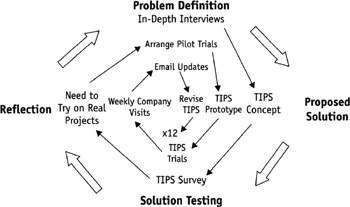Method
|
Action research methodology involves direct researcher involvement and intervention to encourage the introduction of new systems and requisite behavioral and attitudinal changes. This approach has been used successfully in both education research (Cohen and Manion 1994) and when introducing new management systems (Koch et al. 1995). The approach overview developed is shown in Figure 6.

Figure 6: Iterative Action Research Approach Overview
Survey of the TIPS Concept
The twenty-five interviewees from the initial study were sent a summary of the TIPS approach and asked (on a fax-ready reply form) to respond to two leading questions:
-
In what ways could TIPS potentially better meet the innovation project management needs of your organization?
-
What changes or modifications to TIPS are necessary before your organization could consider implementation?
The form of the questions was chosen to invoke comparison between TIPS and existing innovation project management arrangements (already acknowledged as unsatisfactory by the interviewees) and to provoke a considered response. Sixteen responses were acquired from twenty of the original twenty-five interviewees still with their organizations (Table 1).
TIPS Pilot Trials
The three research provider organizations and six successful companies from earlier research (Mills et al. 1999) were invited to consider trying TIPS on a sample of their current projects. Local (Hamilton, New Zealand) firms were particularly encouraged to respond so that direct researcher contact and support could be conveniently provided. After discussions an agricultural research company (R1) and an electronics/ manufacturing company (E1) agreed to use TIPS on three projects in each company. The pilot trial took place between 12 July and 13 October 2000 and had eleven company participants. Formally allocated projects were managed by participants designated A, B, and C and X, Y, and Z, respectively, and overseen by one project portfolio manager from each firm (designated G and H, respectively). One participant (#6) working for R1 with C contributed to a joint survey response and another (#5) working for R1 in association with B also used TIPS on two informal projects and completed the final survey independently. A third participant (#7) was the engineering manager for E1. The functions of the managers, generically described as business/operations (O) or technical/scientific (T), were also identified. The designations, project responsibilities, and functions of the eleven participants are shown in Table 2 and brief descriptions of the six formal projects are shown in Table 3.
| Participant # | Company | Designation | Function |
|---|---|---|---|
| 1 | R1 | G | 0 |
| 2 | R1 | A | 0 |
| 3 | R1 | B | 0 |
| 4 | R1 | C | T |
| 5 | R1 | - | T |
| 6 | R1 | - | T |
| 7 | E1 | - | 0 |
| 8 | E1 | H | 0 |
| 9 | E1 | X | T |
| 10 | E1 | Y | T |
| 11 | E1 | Z | T |
| Notes: R1 and E1 are an agricultural research company and an electronics/manufacturing company respectively, 0 represents business/operations, and T represents technician/scientist functions. | |||
| Project Manager | Project Description |
|---|---|
| A | Development, approval, and launch of a new model of an existing animal remedy. |
| B | Development and launch of an existing production management software product for a different animal species. |
| C | Research, development, and commercialization of a novel animal-based drug production process. |
| X | Development and production of a new network security system. |
| Y | Fixing six specific faults in a recently launched new product and consequential upgrade of production line. |
| Z | Production and packaging for a new hardware/software security product for export. |
During initial discussions, the following three interrelated aspects of the trial emerged as being of particular significance for introducing TIPS:
-
Consolidating the type of information useful for managing innovation projects.
-
Formatting project information for convenient and practical use.
-
Encouraging the flow of project information across functional barriers and managerial levels.
Regular interaction between participants and the researcher (senior author of this chapter) developed in two ways—by visits and by weekly email updates. Each Friday during the three-month trial the project manager was visited at a convenient time (A, B, and C in the morning and X, Y, and Z in the afternoon), usually in the same sequence. The visit was used to assist project managers in updating the TIPS project spreadsheet and to discuss implementation problems and alternative solutions. Each Thursday email updates were sent to suggest solutions to common problems, to provide revised TIPS software, to motivate all participants, and to remind project managers of the Friday visit.
Research data was collected informally through notes made during the weekly visits and on reflection, and formally by a survey at the end of the trial. The survey was sent individually to the eleven participant managers, distributed, and collected through email using a protected Microsoft Excel spreadsheet.
The small number of respondents for the trial (nine) made definitive, statistical analysis by numerical rating alone impractical and unreliable. All answers requiring numerical rating were therefore supplemented with a request to write down the "reason for the rating." This approach allowed aggregate rating values to be verified and enhanced.
Survey formats and rating scales were based on examples provided by Bruner and Hensel (1994) and Aiken (1996) and standardized to five-point scales for consistency and convenience. Survey topics covered three aspects of project management: information content (twenty-seven measures), formatting (fifteen measures), and flow (seven measures). There was also a concluding section on organization-wide implementation requirements and prospects (eight measures).
|
EAN: 2147483647
Pages: 207